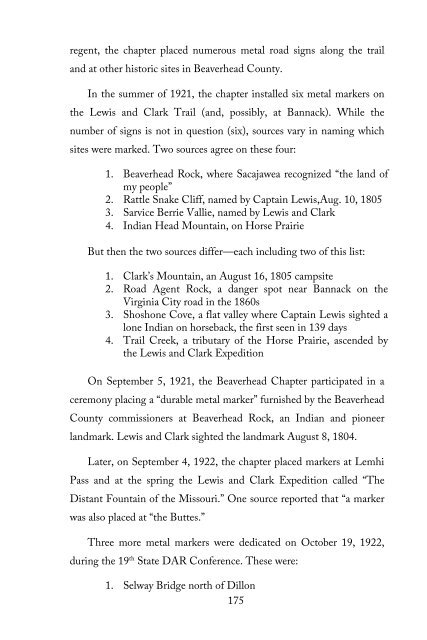Montana's DAR Markers . . . Honoring Where History Was Made
This book is a 200-page thank you to the women of Montana State Society Daughters of the American Revolution for their work in placing historical markers across the state of Montana. Starting in 1908, Montana DAR has installed 70 historical markers across the state. Of those, 33 remain. This book records why the markers’ sites were selected, their history, and the backstory of each.
This book is a 200-page thank you to the women of Montana State Society Daughters of the American Revolution for their work in placing historical markers across the state of Montana. Starting in 1908, Montana DAR has installed 70 historical markers across the state. Of those, 33 remain. This book records why the markers’ sites were selected, their history, and the backstory of each.
Create successful ePaper yourself
Turn your PDF publications into a flip-book with our unique Google optimized e-Paper software.
egent, the chapter placed numerous metal road signs along the trail<br />
and at other historic sites in Beaverhead County.<br />
In the summer of 1921, the chapter installed six metal markers on<br />
the Lewis and Clark Trail (and, possibly, at Bannack). While the<br />
number of signs is not in question (six), sources vary in naming which<br />
sites were marked. Two sources agree on these four:<br />
1. Beaverhead Rock, where Sacajawea recognized “the land of<br />
my people”<br />
2. Rattle Snake Cliff, named by Captain Lewis,Aug. 10, 1805<br />
3. Sarvice Berrie Vallie, named by Lewis and Clark<br />
4. Indian Head Mountain, on Horse Prairie<br />
But then the two sources differ—each including two of this list:<br />
1. Clark’s Mountain, an August 16, 1805 campsite<br />
2. Road Agent Rock, a danger spot near Bannack on the<br />
Virginia City road in the 1860s<br />
3. Shoshone Cove, a flat valley where Captain Lewis sighted a<br />
lone Indian on horseback, the first seen in 139 days<br />
4. Trail Creek, a tributary of the Horse Prairie, ascended by<br />
the Lewis and Clark Expedition<br />
On September 5, 1921, the Beaverhead Chapter participated in a<br />
ceremony placing a “durable metal marker” furnished by the Beaverhead<br />
County commissioners at Beaverhead Rock, an Indian and pioneer<br />
landmark. Lewis and Clark sighted the landmark August 8, 1804.<br />
Later, on September 4, 1922, the chapter placed markers at Lemhi<br />
Pass and at the spring the Lewis and Clark Expedition called “The<br />
Distant Fountain of the Missouri.” One source reported that “a marker<br />
was also placed at “the Buttes.”<br />
Three more metal markers were dedicated on October 19, 1922,<br />
during the 19 th State <strong>DAR</strong> Conference. These were:<br />
1. Selway Bridge north of Dillon<br />
175





